AMD Radeon HD 7790 Review Feat. Sapphire: The First Desktop Sea Islands
by Ryan Smith on March 22, 2013 12:01 AM EST- Posted in
- GPUs
- AMD
- Sapphire
- GCN
- Radeon HD 7000
Compute Performance
As always we'll start with our DirectCompute game example, Civilization V, which uses DirectCompute to decompress textures on the fly. Civ V includes a sub-benchmark that exclusively tests the speed of their texture decompression algorithm by repeatedly decompressing the textures required for one of the game’s leader scenes. While DirectCompute is used in many games, this is one of the only games with a benchmark that can isolate the use of DirectCompute and its resulting performance.
Our next benchmark is LuxMark2.0, the official benchmark of SmallLuxGPU 2.0. SmallLuxGPU is an OpenCL accelerated ray tracer that is part of the larger LuxRender suite. Ray tracing has become a stronghold for GPUs in recent years as ray tracing maps well to GPU pipelines, allowing artists to render scenes much more quickly than with CPUs alone.

Our 3rd benchmark set comes from CLBenchmark 1.1. CLBenchmark contains a number of subtests; we’re focusing on the most practical of them, the computer vision test and the fluid simulation test. The former being a useful proxy for computer imaging tasks where systems are required to parse images and identify features (e.g. humans), while fluid simulations are common in professional graphics work and games alike.

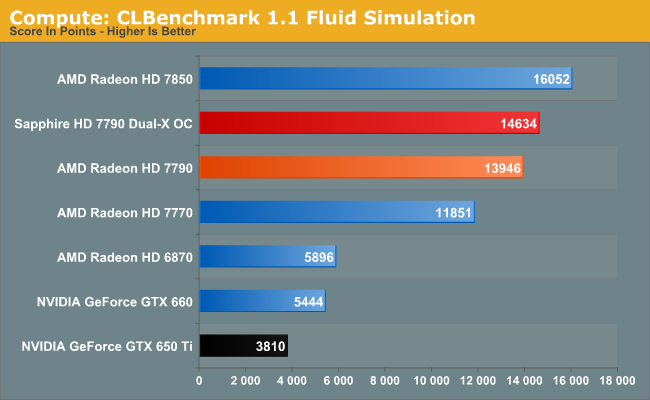
Moving on, our 4th compute benchmark is FAHBench, the official Folding @ Home benchmark. Folding @ Home is the popular Stanford-backed research and distributed computing initiative that has work distributed to millions of volunteer computers over the internet, each of which is responsible for a tiny slice of a protein folding simulation. FAHBench can test both single precision and double precision floating point performance, with single precision being the most useful metric for most consumer cards due to their low double precision performance. Each precision has two modes, explicit and implicit, the difference being whether water atoms are included in the simulation, which adds quite a bit of work and overhead. This is another OpenCL test, as Folding @ Home is moving exclusively OpenCL this year with FAHCore 17.
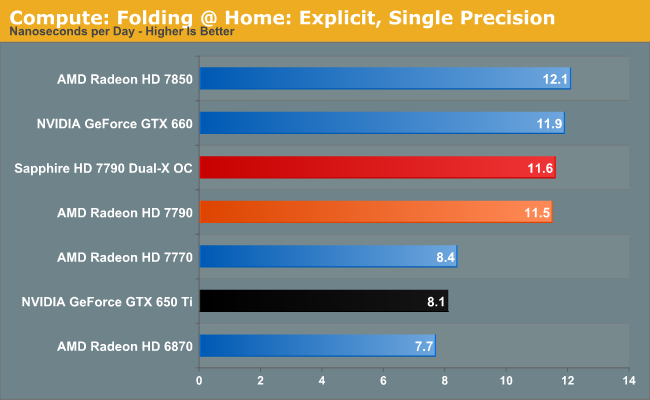
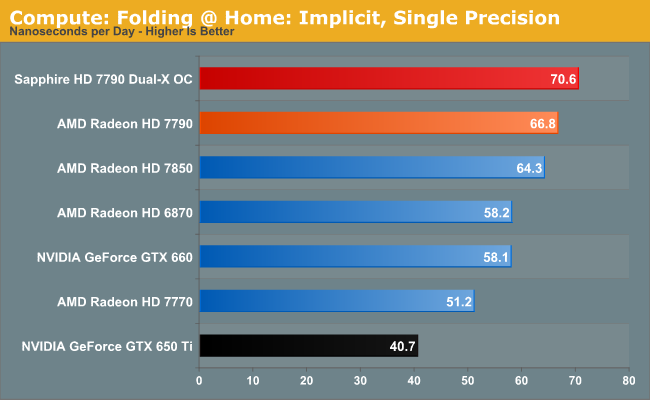
Our 5th compute benchmark is Sony Vegas Pro 12, an OpenGL and OpenCL video editing and authoring package. Vegas can use GPUs in a few different ways, the primary uses being to accelerate the video effects and compositing process itself, and in the video encoding step. With video encoding being increasingly offloaded to dedicated DSPs these days we’re focusing on the editing and compositing process, rendering to a low CPU overhead format (XDCAM EX). This specific test comes from Sony, and measures how long it takes to render a video.
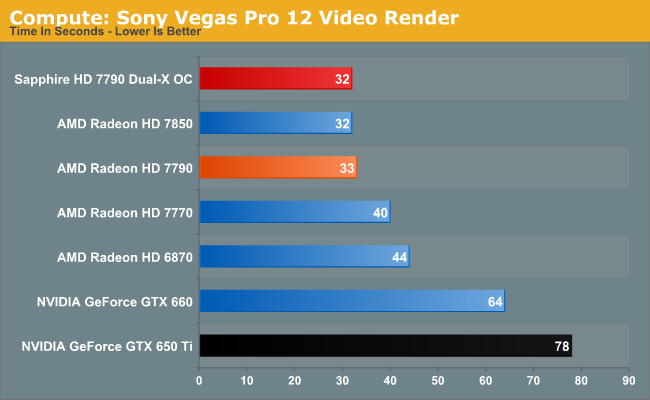
Wrapping things up, our final compute benchmark is an in-house project developed by our very own Dr. Ian Cutress. SystemCompute is our first C++ AMP benchmark, utilizing Microsoft’s simple C++ extensions to allow the easy use of GPU computing in C++ programs. SystemCompute in turn is a collection of benchmarks for several different fundamental compute algorithms, as described in this previous article, with the final score represented in points. DirectCompute is the compute backend for C++ AMP on Windows, so this forms our other DirectCompute test.
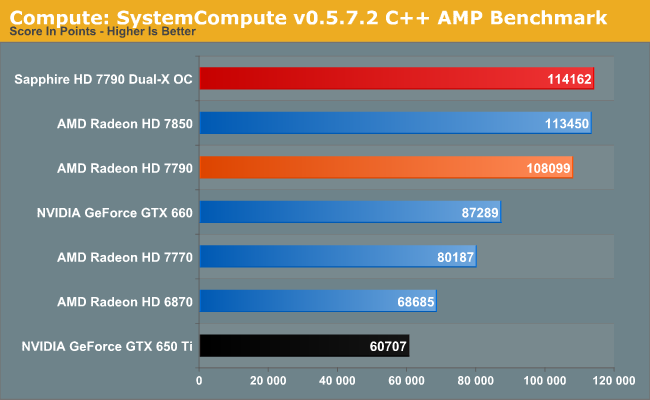


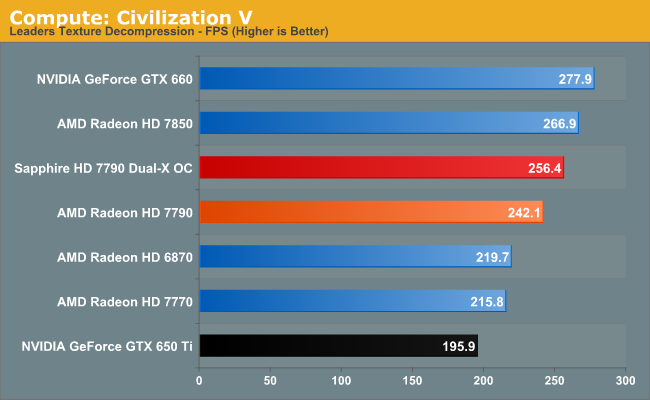








107 Comments
View All Comments
vailr - Friday, March 22, 2013 - link
Didn't AMD originally supply an info-graphic (about a year ago, just prior to the release of their 7000 series cards) that the 7790 card was to have been their lowest-priced 7000 series card that still provided a 256-bit memory interface? Any explanation for the downgrade now, to a 128-bit interface?campcreekdude - Friday, March 22, 2013 - link
I thought the 7890 is supposed to be 256-bit.Oxford Guy - Tuesday, March 26, 2013 - link
The big problem is that it doesn't have enough VRAM. 1 GB is too little for 2013 cards. Pretty ridiculous for one priced at $150.vailr - Friday, March 22, 2013 - link
Info-graphic from a year ago that shows the 7790 with a 256-bit memory bus:http://wccftech.com/amd-radeon-hd7000-28nm-souther...
zshift - Friday, March 22, 2013 - link
Nice catch!CeriseCogburn - Saturday, March 23, 2013 - link
Amd lies all the time then fails to deliver, so the fanboys give them a thousand breaks, another chance, some more time - " in the future what AMD I bought today will be great, it's "futureproof" " (even though it doesn't work correctly right now)...LOL - goodbye amd
So the beta driver, uhh perma beta driver must have crashed out in civ5 a lot.
eric.zaba@gmail.com - Sunday, March 24, 2013 - link
im sorry but if you must insist on invalid staments you shouldnt be on this website because smarter people will correct you on YOUR fanboyness. First of all amd beats nvidia at every price point(check linus tech tips on his youtube video card chanell) and they have perfect drivers. working for 6 months on the same amd driver and no crashes. infact i tried a new crysis 3 driver and it didnt crash then either and that was a beta driver. and my radeon 7770 destroyed the nvidia gtx 650, which is at the same price point.medi01 - Sunday, March 24, 2013 - link
I hope you work for nVidia.Because writing such crap for free is hard to imagine.
Gigaplex - Sunday, March 24, 2013 - link
How do you keep a straight face when accusing others of being fanboys? You're the biggest fanboy I've ever seen.Deo Domuique - Sunday, March 24, 2013 - link
AMD Peasants, that's what we are... First time in my over 15-years "career" on PC gaming I went with AMD and a 7950, and you can't even imagine how much I regret it.